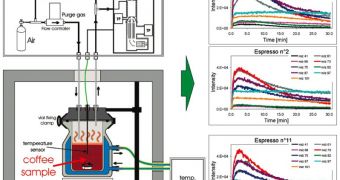Machines perform with no mistake. A human nose may not work well when influenced by other scents, or when it has adapted to a specific scent. And here comes this SF technique: a Swiss coffee tasting machine that turns human tasters obsolete.
New "electronic tasters" like the new coffee-tasting machine could work as quality control devices for monitoring food processing. The new machine was developed by a team led by Christian Lindinger, at Nestl? Research Center, and it is the result of many years of research during which scientists have been searching for technological methods that would replace human sensory capacities.
Coffee produces over 1,000 volatile chemicals, but only about 50 combine to form the complex coffee flavor. A mass spectrometer detects the amounts of 30 of the main compounds in the air above a cup of of coffee. Chemical patterns were established for 11 specific aromas.
The team put trained coffee experts to assess 11 types of coffee, giving them marks from 0 to 10 for the strength of each of 11 aromas - coffee, bitter, cocoa, roasted, woody, cereal, butter toffee, acid, citrus, wine and flowery. Aromas predicted by mass spectrometry analysis almost matched the evaluations of the human testers.
"The new tasting machine assessed the taste and aromatic qualities of espresso coffee nearly as accurately as a panel of trained human espresso tasters," wrote the authors.
"Until now it has always been less effective to ask humans to taste it. Machines will never completely replace humans in this role as the fine tuning will always have to be done by tasters. However I think it will be possible to use machines to detect for obvious defects," said Lindinger, whose study was published in "Analytical Chemistry."
The machine analyzes the presence of 30 gases in the air above a heated espresso sample, and that data is translated into taste parameters connected to one of the 11 specific aromas, based on a "sensory evaluation dataset," which the machine will describe in words.

 14 DAY TRIAL //
14 DAY TRIAL //